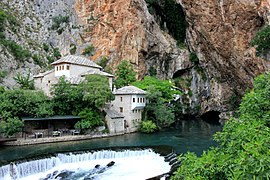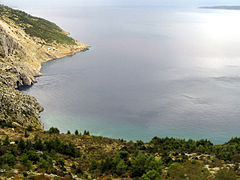Karst spring

A karst spring is a spring that is part of a karst system . This includes the underground drainage of a larger area, which means that karst springs often have a very large bed .
If a karst spring has a funnel-like or kettle-like shape, such water outlet points are also known as spring pot , which is reflected in water names such as Aachtopf , Blautopf , Brenztopf or Lonetopf . Other karst springs arise from rock faces, such as the Kuhfluchtquelle , the Source du Lison , the Dead Woman or the Rinquelle .
In some cases, particularly large (or old) karst springs are the end of a cave system at which a cave river reaches the surface of the earth. It is often possible to enter and explore this cave system at the karst spring. There are also exit points from caves (water caves) that are still completely filled with water, or at least when there is high rainfall.
Karst springs, the direction of which can be reversed depending on the amount of rainfall, so that they then function as a ponor , are called Estavelle .
In North Africa, water outlet points are known as spring pots or ain , which emerge through the effect of an artesian basin and are of particular importance in arid areas. They can pump out flowing water or emerge under evaporitic salt crusts. Well-known examples can be found in the oases of the Tunisian landscape of Bled el Djerid and in the entire area around the depressions Chott el Djerid and Chott el Gharsa . Here it is water-bearing layers, mostly sand or sandstone, that act as aquifers .
Hydrological peculiarities
The most important peculiarity of karst springs results from the fact that in areas with superficial carbonate rock this is transformed into soluble calcium hydrogen carbonate over time by the carbonic acid content of the rainwater . This creates caves and subterranean streams so that the water emerges from a spring after just a few days. In contrast to groundwater, there is no purification and there are very different types of pouring: storms, snowmelt and seasonal fluctuations in the amount of precipitation are clearly noticeable at the source. The source of the Aach , for example, occupies a special position because its water does not come from rain, but from seepage from the Danube around 12 km away.
Another special feature are karst springs, which arise after their underground path in the mainland (mostly through carbonate rock ) under water. Such underwater karst springs are a focus of modern research around the Mediterranean .
Many karst springs fall dry in times of low rainfall, which is then referred to as intermittent springs. Still others are dry for most of the year and only pour after heavy rainfall. Sources that pour only in wet years are often called famine wells , which is because the vernacular sees a connection between the pouring of the spring and poor yield in a rainy year. However, it is more of a culturally based superstition . Scientific studies on various hunger wells could not prove such a connection.
The quality of karst spring water is extremely unsuitable for the drinking water supply due to the lack of cleaning and high hardness . In addition, uneven pouring is offset by even consumption, and even low pouring in summer is accompanied by an increased demand. For these reasons, karst springs are rarely used for drinking water supply today.
Karst spring of the Loue in France
Karst spring of the Kamenscica in Gorski Kotar in Croatia
Creux-Genat in Switzerland
Vrelo Bune in Bosnia and Herzegovina
Examples
Some selected examples of karst springs:
- Blautopf (Germany)
- Foce del Timavo (Italy)
- Izvor Omble (Croatia)
- Pießling origin (Austria)
- Source du Doubs (France)
- Siebenbrünnen (Switzerland)
- Syri i Kaltër (Albania)
- Vrelo Bune (Bosnia and Herzegovina)
Lists of karst springs
- List of karst springs
- List of karst springs in Germany
- List of karst springs in France
- List of karst springs in Austria
- List of karst springs in Switzerland
- List of karst springs in the United States
Tuhala Witch Fountain (Estonian Tuhala nõiakaev) Tuhala , Estonia
Submarine karst spring, Arcadia , Peloponnese
A submarine karst spring ( vrulja ) near Omiš can be recognized by the rippling water surface.
Karst spring of the Sorgues River at Fontaine-de-Vaucluse . The water comes to the surface from a depth of 315 meters.









